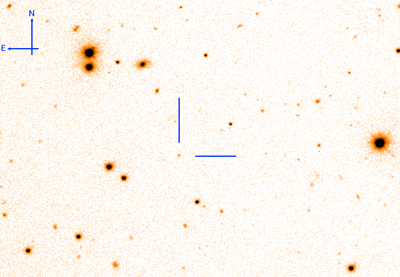Research on supernovas and gamma ray bursts offer novel vision of the death of massive stars
A consortium, in which the UPV/EHU-University of the Basque Country and the CSIC (Spanish National Scientific Research Council) are participating, has taken a qualitative and quantitative leap forward when studying three phenomena simultaneously
First publication date: 22/12/2014

An international consortium, in which the University of the Basque Country (UPV/EHU), Ikerbasque and CSIC are participating, has published in a single article a compendium of data obtained after the simultaneous research of three supernovas and of their corresponding Gamma-Ray Bursts (GRB). The research enabled contrasting statistically that the supernovas associated with GRB emit greater quantities of nickel compared to those not linked to GRB. Participating in this study were researchers from 19 countries and who employed 13 telescopes distributed throughout the planet. The results have been published in the prestigious Astronomy & Astrophysics journal.
Gamma-Ray Bursts are brief and intense flashes of gamma radiation that occur randomly in the heavens at a rate of approximately three per day. Since 2003 astrophysicists believe that at least a large part of these gamma ray outbreaks are linked to supernovas; nevertheless, not all supernovas emit gamma rays.
Data of great quality
The sample studied by this international consortium was made up of three GRBs and their respective supernovas. It should be stressed that the quality of the data obtained from one of the supernovas has enabled knowledge to be gained of the properties of the neutron star that can result from the explosion. In concrete, it could be shown that the neutron star behaves like a gigantic spinning top of various kilometres radius, and with a high period of rotation (12 milliseconds) and an intense magnetic field (100 billon Gauss, the Earth's magnetic being only half a Gauss).
The research on the association of a GRB with a supernova required great international effort, as it was necessary for telescopes at various observatories to monitor the evolution of the intense brightness over months. This explains that, after eleven years since the GRBs were first linked to supernovas, only a few cases have been published in the international literature. This new and novel study presents - in just one publication - a compendium of three GRBs associated with three supernovas, in what is a qualitative and quantitative leap forward in the number of supernovas that have been linked to GRBs. The UPV/EHU has had the honour of taking part for the first time in one of these great international consortia.
'Small' stars and 'massive' stars
Astrophysicists have known for decades now that stars are born, they mature and then die in different ways. There have been many research studies undertaken in this field which have helped to understand the mechanisms by which stars terminate their lives. It is thus known that "small" stars (with masses approximately less than 9 times the mass of the Sun) end their lives placidly, slowly extinguishing in the same way as an incandescent metal cools down. Our Sun belongs to this type of star, able to live for a long period of time (for approximately 10,000 million years) before burning out definitively. "Massive" stars (with masses greater than approximately 10 solar masses) have much more agitated lives however. After a life of approximately 30 million years (at the most), these stars of great mass violently explode as a supernova.
A supernova is simply the result of a complex explosion in a spherical form that happens when the star runs out of its nuclear fuel. It has been well established by astrophysicists that in the interior of such explosions a central object of very high density arises. This remnant of the explosion can be a neutron star or a black hole, depending on the mass of the star. The density of these objects is so high that it is equivalent to concentrating all the mass of a commercial aircraft into one grain of sand.
The Associated Unit
Both the Planetary Sciences Group at the UPV/EHU-University of the Basque Country and Ikerbasque have participated in this study through the Associated Unit that the Institute of Astrophysics of Andalusia (IAA), which belongs to the Spanish National Scientific Research Council (CSIC), set up under the auspices of Euskampus at the Faculty of Engineering (ETSI, Bilbao). Among many other advantages, this collaboration is an added benefit enabling the Associated Unit to participate in large international consortia with access to the best telescopes on the planet. The Associated Unit is jointly led by Agustín Sánchez Lavega, the UPV/EHU professor at the Faculty of Engineering (ETSI, and who is also the head of the Aula EspaZio Gela), and by Javier Gorosabel, scientific researcher at the CSIC and an Ikerbasque Research Professor at the ETSI.
Bibliographic reference
Cano, Z.; de Ugarte Postigo, A.; Pozanenko, A.; Butler, N.; Thöne, C. C.; Guidorzi, C.; Krühler, T.; Gorosabel, J.; Jakobsson, P.; Leloudas, G.; Malesani, D.; Hjorth, J.; Melandri, A.; Mundell, C.; Wiersema, K.; D'Avanzo, P.; Schulze, S.; Gomboc, A.; Johansson, A.; Zheng, W.; Kann, D. A.; Knust, F.; Varela, K.; Akerlof, C. W.; Bloom, J.; Burkhonov, O.; Cooke, E.; de Diego, J. A.; Dhungana, G.; Farina, C.; Ferrante, F. V.; Flewelling, H. A.; Fox, O. D.; Fynbo, J.; Gehrels, N.; Georgiev, L.; González, J. J.; Greiner, J.; Güver, T.; Hartoog, O.; Hatch, N.; Jelinek, M.; Kehoe, R.; Klose, S.; Klunko, E.; Kopa?, D.; Kutyrev, A.; Krugly, Y.; Lee, W. H.; Levan, A.; Linkov, V.; Matkin, A.; Minikulov, N.; Molotov, I.; Prochaska, J. X.; Richer, M. G.; Román-Zúñiga, C. G.; Rumyantsev, V.; Sánchez-Ramírez, R.; Steele, I.; Tanvir, N. R.; Volnova, A.; Watson, A. M.; Xu, D.; & Yuan, F. A trio of gamma-ray burst supernovae:. GRB 120729A, GRB 130215A/SN 2013ez, and GRB 130831A/SN 2013fu. Astronomy & Astrophysics, Volume 568, id.A19, 16.






